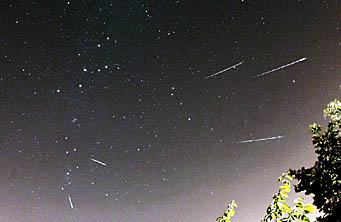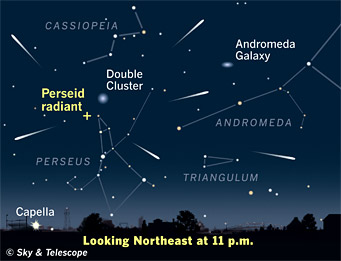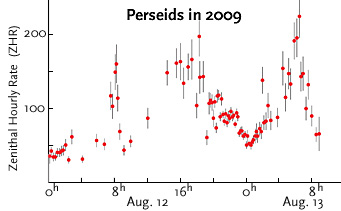Update, August 13: The zenithal hourly rate made it up to about 70 to 90 and stayed there for at least 18 hours, according to early reports to the International Meteor Organization. The time of the predicted peak (0 hours August 13th UT) has passed, but at weaker levels the show will go on for days.
Update, August 12: Yup, the Perseids are happening right on schedule. Lots of lovelies! By 0 hours Universal Time today (good meteor-watching time for Europe), the shower's zenithal hourly rate was up to about 40.
The peak of the shower itself is predicted for about 0 hours UT August 13th. Track the shower's progress with the International Meteor Organization's near real-time activity profile, based on reports being sent in by the IMO's visual observers worldwide.
Lots of photos at Spaceweather.com.

Gain Lee recorded this montage of bright Perseids over a two-hour period in August 2007 from his heavily light-polluted backyard in Huddersfield, England. He took many short exposures with a 15-mm f/2.8 fisheye lens, then combined the lucky few frames that captured a meteor with one that included the foreground. Click here for a wider view, which shows Cassiopeia near center and the shower's radiant point below it in northern Perseus. The nonconformist meteor off by the Big Dipper at far left is a Kappa Cygnid.
Gain Lee
Original article: The last time the annual Perseid meteor shower happened during a run of good moonless nights was in 2007. It turns out that every three years, the same phase of the Moon returns to roughly the same date each month (2.2 days earlier, on average). So in 2010 we're on for moonless Perseids again!
The shower lasts for many days, but according to the International Meteor Organization this year's peak should occur during a half-day-long window centered on 1:00 Universal Time on August 13th, which is ideal timing for skywatchers in Eurasia. For North Americans, the best viewing will probably be late Thursday night and early Friday morning, August 12-13, or possibly the night before.
In any case, prime viewing for the Perseids is from about 11 p.m. or midnight (local time) until the first light of dawn. This is when the shower's radiant (its perspective point of origin) is well up in your sky. The higher the radiant, the more meteors you'll see.

The Perseid meteors appear to stream away from their radiant near the border of Perseus and Cassiopeia. And while you're outside on a dark night, don't forget to look for the Double Cluster and the Andromeda Galaxy, two of the easiest "faint fuzzies" to spot with your unaided eyes.
S&T Illustration
Many longtime skywatchers remember the fine displays the Perseids put on in the early 1990s, around when the shower's parent comet, 109P/Swift-Tuttle, last passed through the inner solar system. Those days are gone; the comet won't be back until 2126. But even now some, thin, dense filaments of meteoroids that the comet shed in recent centuries continue to liven up the shower's behavior. Strands left behind by the comet in 441 and 1479 might be in play this year, though only a little enhancement is expected from them.
At a very dark, rural site, you can probably expect to see 100 or more meteors per hour when the radiant (in northern Perseus) is highest in your sky before the first light of dawn. Any light pollution will cut down on the numbers, as will the radiant's lower altitude earlier in the night. But the brightest few meteors shine right through light pollution, and the few that happen when the radiant is low are especially long, skimming the upper atmosphere and flying far across the sky.
To get the most enjoyment while watching for Perseids, find a dark spot with an open sky view, bundle up thoroughly in blankets or a sleeping bag (for mosquito shielding as well as warmth, and don't forget the repellent), and lie back in a reclining chair. Gaze into the stars, and be patient. The best direction to watch is wherever your sky is darkest, usually straight up, perhaps with a little inclination toward the radiant. That's all there is to it!

In 2009 the Perseid shower displayed three separate, strong peaks during its most active 36 hours (shown in Universal Time), as revealed in this plot based on 8,158 Perseid sightings reported by 144 observers worldwide.
Geert Barentsen / IMO
If you're a little more ambitious, you can make a careful meteor count and report it to the International Meteor Organization. Such counts are analyzed to yield the shower's zenithal hourly rate, which is the number of meteors that a single observer would see per hour under ideal conditions: with the radiant directly overhead (at the zenith) and the sky dark enough to reveal 6.5-magnitude stars.
Not all the meteors you'll see are Perseids. In addition to occasional random, sporadic meteors, the weaker Delta Aquarid shower is also active during Perseid season. The Delta Aquarids are slower, often yellower, and track away from a radiant point in eastern Aquarius. Weaker still are the Kappa Cygnids, identifiable by their flight direction away from Cygnus in an altogether different part of the sky.
Don't forget that the Perseid shower lasts for more than one night! Rates are about a quarter to half the peak for one or two nights before and after. A few forerunners of the shower may show up as early as July 20th, and stragglers have been recorded as late as August 24th.
 18
18









Comments
Tom Hoffelder
July 27, 2010 at 11:42 pm
Every article about the Perseids always has something to the effect of the best hours being after midnight to dawn. This is of course true, if the subject is more meteors. But, if the subject is most spectacular meteors, I would submit that the time to watch is as soon as it gets dark. When the radiant is low, you see fewer meteors, but the bright ones will streak nearly across the entire sky, as noted in the above article. As the radiant rises, the meteors are shortened. So, I'm rather excited about the predicted peak being centered around 9 PM EDT on the 12th! A question of quality vs quantity?
You must be logged in to post a comment.
scyntax
July 31, 2010 at 7:05 pm
Bundle up in blankets or a sleeping bag? I live in the Sonoran desert in Arizona. How many blankets and sleeping bags should I use?
You must be logged in to post a comment.
dk2852
August 5, 2010 at 7:43 pm
I am looking very forward to this. Not only is it the first moonless Perseids in a while, but I will be staying in a great dark sky site in Montana during the showers. So excited!
You must be logged in to post a comment.
Troy
August 6, 2010 at 2:49 pm
Just wanted to say that I've seen some pretty good metors lighting up the sky the last couple of night. I'm not sure if they were Perseids, Aquarids, or Cygnids, but teither way they were impressive. One left a nice 25 degree long smoke trail!! (these were seen just north east of Hercules)
You must be logged in to post a comment.
Troy
August 6, 2010 at 3:02 pm
Well, now that I've thought for a little bit (and remembered where perseus is located! Duh!) these are Perseids. If this is any indication then it should be a pretty good shower!!!
You must be logged in to post a comment.
Goldie
August 8, 2010 at 7:34 pm
Does anyone know a good spot to watch Perseids in the San Francisco Bay area or nearby? Thanks for any help.
Am looking forward to the display.
Goldie
You must be logged in to post a comment.
Will
August 11, 2010 at 9:28 am
My son will be flying east over the Atlantic during the shower. Can you star gaze from the back of a jet in the middle of the night?
You must be logged in to post a comment.
rcb
August 11, 2010 at 11:22 am
I once saw the Northern Lights from a plane and it was very cool.
You must be logged in to post a comment.
Pete from Canton MI
August 11, 2010 at 5:49 pm
I have been tingley for days.
You must be logged in to post a comment.
arlenbrack
August 12, 2010 at 12:56 am
I just learned of this, and am anxious to find out if I will be able to view. It's now 2:50 am Thurs 12th, and I've not been able to see anything yet. I'll go out when I'm finished with this post. Good thing for me, the sky is perfectly clear and my location in Anastasia Island, St Aug, Fla. I'm going to walk down to the beach and look NE - there's nothing out there except sky and ocean.
You must be logged in to post a comment.
Evan James
August 12, 2010 at 12:35 pm
so excited looking forward to seeing one of the best meteor showers of the year. hope the weather holds out in my area.
You must be logged in to post a comment.
evan
August 12, 2010 at 12:51 pm
i am so excited about tonight's meteor shower. I always watch them every year. hope the Perseids put on a good show tonight
You must be logged in to post a comment.
jason
August 12, 2010 at 8:13 pm
I won't be able to view this at all... ): There are storms over Minnesota and Wisconsin all through out the night and tomorrow. I'm pretty sad.
You must be logged in to post a comment.
cathy
August 12, 2010 at 10:17 pm
they're here. in wisconsin, very cool but lots of mosquitos are out also
You must be logged in to post a comment.
cathy
August 13, 2010 at 2:31 am
too cloudy to see anything now, good thing i looked earlier but i saw things happening when i looked south and southwest, was i seeing something else because i saw 3 times what i thought were meteors and nothing in the northeast.
You must be logged in to post a comment.
Sam.G
August 13, 2010 at 8:12 am
We Saw Many Perseus meteor showers today Aug 13 early morning more than 40, nos,every 5 minute once at Pegasus,Taurus Andromeda, Auriga Perseus Constellations Near Chennai (madras, Tamil nadu)IST Indian time A.M,02.30
Sam.G
Om prakass
You must be logged in to post a comment.
Melanie
August 13, 2010 at 1:04 pm
I couldn't see anything last night, the 12th, since it was cloudy, and we're supposed to get thunderstorms tonight, but tomorrow night's forecast is mostly clear. That's not very far away from the peak date. How good will the shower still be?
You must be logged in to post a comment.
John
August 14, 2010 at 2:45 pm
So far it's been a total bust. Have been out the last 2 nights, Thurs 12 and Fri 13th and just 2 sightings on Thursday.
Been watching this annually for a number of years and used to have great shows back in Ontario.
We're way in the country about 13km outside Shelburne, NS, no light pollution and no perseids.
Very frustrating
You must be logged in to post a comment.
You must be logged in to post a comment.